People can no longer depend on ponds and wells for the water they need to drink, cook and wash.
Rising salinity is causing daily water struggles for people living along Kerala’s coastline.
Salt water's intrusion into fresh water is a growing problem linked to climate change.
It means residents in Chellanam, India can no longer depend on ponds and wells for the water they need to drink, cook and wash.
Anthony Kuttappassera's family has lived in the same house at the edge of the Arabian Sea for more than a century. He grew up drinking water from the pond and the well outside his home.
But in recent decades, that water gradually became too salty to drink. Then it grew too salty for bathing or washing clothes.
Now, the pond is green, full of bugs and nearly dry - just like the rest of the wells and ponds in the Chellanam area of Kochi, a city of about 600,000 people on India's southwestern coast.
Why is salt water entering freshwater sources?
Near coastlines across the world, freshwater sources are at risk from salt water intrusion.
Groundwater can become contaminated with seawater due to rising sea levels, increased water demand and recurring drought.
Changing ocean patterns, extreme storms and over-development also contribute to the growing salinity problem in the Kochi region.
"Salinity has increased by 30 per cent to 40 per cent since the first studies of water in the area in 1971," says Bijoy Nandan, dean of marine sciences at Cochin University of Science and Technology.
How do villagers get fresh water?
Pipelines bring fresh water from inland to Chellanam but these often suffer months-long breakages.
This leaves residents queuing to get a daily dose of fresh water delivered by a truck. Each truckload of water has to be poured into barrels and buckets and carried by hand to the village's households.
"The area's residents have to pay 100 to 200 rupees [about €1.11 to €2.21 per day] for the water they need to drink, cook and wash," says the vicar of St. George Church in South Chellanam, Reverand John K. That can be around 15 per cent of their daily income.
Some residents choose to use a wooden boat to cross a small stretch of backwater and get fresh water from the neighboring district of Alleppey. However, the result is a higher demand on a single tap in Alleppey resulting in conflicts with the locals.
A look into the future?
The 1.4 billion people living in India largely depend on groundwater sources.
The challenge in coastal areas comes in a nation where access to fresh water was already an issue. Less than half of India's population has access to clean drinking water, according to UNICEF.
And climate change will almost certainly exacerbate the problem in the future, with more frequent and severe droughts and further sea level rise expected.
Although salt water invasion of crucial groundwater supplies is a problem around the world, richer nations can adapt more easily. However, infrastructure and service disruptions could cost billions of dollars annually.
It hits harder in countries like India, still regarded as a developing nation even as it has grown into one of the world's largest economies.
Watch the video above to learn more about this story.












